|
Tags: Lu Hao-tung | national flag | Republic of China | Sun Yat-sen
The emblematic pattern of the Republic of China's national flag -- the white sun in a blue sky -- was originally designed by Lu Hao-tung in 1893 for the Chinese revolutionists. Later a crimson background was added by Dr. Sun Yat-sen in 1906. Following the victories in the Northern Expedition and the unification of China, the flag rich in symbolic values, was formally stipulated as the national flag of the Republic of China on December 17, 1928 by the National Government. Thereafter, it was used nationwide.
This section features the national flag-related historical documents selected from the National Government Archives, from which both the background and the process of the flag's transformation from the Blue Sky with a White Sun and Red Earth flag into the ROC national flag can be traced and examined.
 On December 17, 1928, the Blue Sky with a White Sun and Red Earth flag was formally announced as the national flag of ROC by the National Government. Its symbolic representation of the nation has been in effect since then, which has also been clearly defined in Article Six of the Constitution. Because the specific regulations concerning the size and design of the national flag are not widely known, here presented for review is the national flag-related historical documents selected from the National Government Archives, from which the regulations, specifications, and use of the national flag can be best examined.
On December 17, 1928, the Blue Sky with a White Sun and Red Earth flag was formally announced as the national flag of ROC by the National Government. Its symbolic representation of the nation has been in effect since then, which has also been clearly defined in Article Six of the Constitution. Because the specific regulations concerning the size and design of the national flag are not widely known, here presented for review is the national flag-related historical documents selected from the National Government Archives, from which the regulations, specifications, and use of the national flag can be best examined.
The Blue Sky with a White Sun and Red Earth flag was originally designed by Lu Hao-tung in the autumn of 1893 (the nineteenth year of the Guangxu reign of the Qing dynasty) and was used by the revolutionary armies. In 1906 (the thirty-second year of the Guangxu reign of the Qing dynasty), the Chinese revolutionary alliances assembled to discuss the problem with the flag, and Huang Shin disapproved of the “Blue Sky with a White Sun” flag on account of its homely appearance and resemblance of Japan's Sunrise flag. Consequently, the “Red Earth” was later added as backdrop by Dr. Sun Yat-sen, and thus gave birth to the Blue Sky with a White Sun and Red Earth flag.
However, the “Blue Sky with a White Sun and Red Earth” flag had not become the official ROC national flag until the end of 1928 (17 years after the ROC was established). After the Wuchang Uprising and the overthrowing of the Manchurian Qing government, a temporary National Government of the Republic of China was established in Nanjing. In January, 1912 (the first reign year of the Republic of China), the temporary Senate assembled to discuss the issue about the flag representing the nation.
Since the flags used by the revolutionary armies varied from one to the other during the Wuchang Uprising, a dispute among the representatives from various provinces thus arose. These flags were different in designs, including the Iron Blood Eighteen-Star flag used by the Progressive Society in Hubei, Hunan, and Jiangxi Province (also called the Nine-Point flag representing the 18 administrative provinces at that time), the Five-Colored flag used by the Alliance Society in central China such as Jiangsu, Zhejiang, and Anhui Province (the five colors were red, yellow, blue, white, and black, each representing the five major nationalities of China: Han, Manchu, Mongol, Hui, and Tibetan), the Blue Sky with a White Sun and Red Earth flag used by Guangdong, Guangxi, Fujian, Yunnan, and Guizhou Province that followed Dr. Sun Yat-sen's flag design, and the Hash flag used during the insurrection led by Chen Chiung-ming in Huizhou but later abandoned in his subsequent reunion of the armies in Guangzhou.
Finally, in order to put an end to the disagreement, the temporary Senate offered a compromise between different parties and petitioned the president to sanction and announce the resolution: the Five-Colored flag was chosen as the national flag, the Iron Blood Eighteen-Star flag as the army flag, the Blue Sky with a White Sun and Red Earth flag as the navy ensign, the Hash flag with blue squares and white bars as the ensign for the general of the army, and the Hash flag with white squares and blue bars as the ensign for the deputy general of the army. However, Dr. Sun Yat-sen, the temporary president of the Republic of China, vetoed the resolution owing to his consideration of the underlying inappropriateness in the historical and symbolic meanings of the Five-Colored flag. Therefore, he issued a letter to the Senate, which favored putting the flag to public vote after the elected congress was established. Afterwards Yuan Shi-kai ascended to the temporary presidency. On April 1, the National Government relocated to Beijing. On May 10, the Senate assembled again to discuss the flag issue, the result of which remained the same as that maintained in the meeting held in Nanjing, that is, the Five-Colored flag was acknowledged as the national flag.
On April 10, 1921, the Extraordinary Congress elected Dr. Sun Yat-sen to be the Extraordinary President of Nationalist China in Guangzhou. On May 5 of the same year, he assumed office and announced the Blue Sky with a White Sun and Red Earth flag to be the national flag. In July, 1926, the National Government in Guangzhou initiated the Northern Expedition, and won victories in northeastern China in December, 1928. Since then, the national flag has been flown everywhere throughout China. On November 2, the National Government in the fifth State Council established the “National Emblem and National Flag of the Republic of China Act”, followed by the formal promulgation on December 17 of the Blue Sky with a White Sun as the national emblem, and the Blue Sky with a White Sun and Red Earth flag as the national flag of the Republic of China.
On December 25, 1946, the flag was specified in Article Six of the Constitution: the national flag of the Republic of China features red earth as background and the blue sky with a white sun located on the top left corner of the flag. In 1954, the “National Emblem and National Flag of the Republic of China Act” was amended through legislative procedures, then announced by the president on October 23 of the same year, and has been applied up to date.
The National Museum of History has provided 24 graphic files such as the “Written Instruction from the KMT's Central Executive Council to the National Government,” the “National Government’s Official Announcement of the National Emblem and National Flag of the Republic of China Act,” the “National Emblem and National Flag of the Republic of China Act,” the “Draft National Emblem and National Flag of the Republic of China Act with Illustrations”, the “Illustration on the Sizes, Ratios, Techniques for Geometric Drawing of the National Emblem and ROC National Flag,” the “Terms of Fabrication and Use for the ROC National Flag and KMT Flag, ” the “Graphic Pattern of the KMT Flag,” the “Graphic Pattern of the ROC National Flag,” the “Graphic Pattern, Sizes, Ratios, and Techniques for Geometric Drawing of the KMT Flag,” the “the Scale of Various Sizes of the KMT Flag,” and the “Scale of Various Sizes of the ROC National Flag”.
The inclusion of the written instruction from the KMT’s Central Executive Council and the KMT’s emblem is related to Article Five concerning the establishment of the nation in Dr. Sun Yat-sen's “Fundamentals of National Reconstruction”: the Military Rule Period, the Political Tutelage Period, and the Constitutional Government Period. Following the success of the Northern Expedition, the National Government replaced the Northern Warlords Government, thus marking the initiation of the Political Tutelage Period, during which the Chinese Nationalist Party (KMT) represented the voice of people of the country and led the government, and the national flag changed from the Five-Colored flag to the Blue Sky with a White Sun and Red Earth flag. According to the National Government Archives, the flag-related laws and regulations such as the “National Emblem and National Flag of the Republic of China Act” and the “Terms of Fabrication and Use for the ROC national flag and KMT flag” were passed by the KMT's Central Executive Council, and announced and implemented by the National Government.
The ROC national flag has its origin and history. The transformation of the Blue Sky with a White Sun and Red Earth flag into the ROC national flag was closely related to the historical background of the time. Therefore, acquiring its background knowledge will facilitate our understanding of the historical values of the national flag.
Copyrights: the National Museum of History
Designed by: Digital Archives Project on National Files & Presidential Cultural Artifacts preserved by the National Museum of History
The Story of the National Flag—Historical Documents about the ROC National Flag selected from the National Government Archives

Terms of Fabrication and Use for the ROC National Flag and KMT Flag
- Topic & Key Words: Topic: Jurisdiction - Legislation
- Description & Explanation: Description of the Contents: Central Executive Council's stipulation on the hanging position, fabrication, and use of the KMT flag and ROC national flag
- Data Identification: 001010013001

Regulations on the Fabrication and Use for the ROC National Flag and KMT Flag
- Topic & Key Words: Topic: Jurisdiction - Legislation
- Description & Explanation: Description of the Contents: The regulations on fabrication and use for the ROC national flag and KTM flag
- Data Identification: 001010013002

Regulations on the Raising and Lowering of the ROC National Flag and KMT Flag
- Topic & Key Words: Topic: Jurisdiction - Legislation
- Description & Explanation: Description of the Contents: Regulations on the raising and lowering of the KMT flag and ROC national flag, regulations on fabrication, use, raising, lowering, and folding of the KMT flag and ROC national flag, and flag raising and lowering rituals
- Data Identification: 001010013003

The National Emblem and National Flag of The Republic of China Act (2)
- Topic & Key Words: Topic: Administration – National Decrees and Regulations
- Description & Explanation: Description of the Contents: All provincial and municipal governments ordered subordinates to observe the National Emblem and National Flag of the Republic of China Act. Considering each foreign embassy's demand for graphic references, the Ministry of Foreign Affairs applied for the issue of the graphic pattern samples of the national emblem and national flag. The Ministry of Internal Affairs made a request for approving the regulations on flying a flag at half-mast
- Data Identification: 001010013005
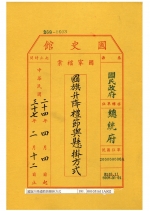
Flag Etiquette Standards on the Raising, Lowering, and Hanging of a Flag
- Topic & Key Words: Topic: Internal Affairs– Etiquette and Dress Code
- Description & Explanation: Description of the Contents: Whether being indoors or outdoors, one (e.g. Chiang Kai-shek) has to stand at attention facing the flag to pay respect while it is being raised or lowered. The Military Committee requested for composing the music for raising and lowering of the national flag. The Central Executive Council assembled to confirm the regulations on lowering the flag at half-mast. The Ministry of Internal Affairs made a draft regarding the hanging methods of the national flag observed by all government authorities
- Data Identification: 001051611002

Dispute about Overseas Chinese Hanging up the ROC National Flag on National Day
- Topic & Key Words: Topic: Foreign Affairs – Affairs concerning nationals living abroad
- The Royalists opposed the hanging of the ROC national flag overseas. The written instruction was sent to the ROC ambassadors in Mexico, which advised giving strengthened exhortations to flag hanging.
- Data Identification: 001067008001
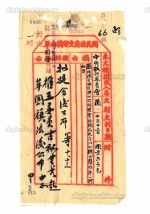
Written instruction from the KMT's Central Executive Council to the National Government announcing amendments made to the sizes and ratios of the ROC national flag and KMT flag and requiring subordination to the dictates of the amended specifications. (October 12, 1928)
Written instruction from the KMT's Central Executive Council to the National Government announcing amendments made to the sizes and ratios of the ROC national flag and KMT flag and requiring subordination to the dictates of the amended specifications. (October 12, 1928)
Written instruction from the KMT's Central Executive Council to the National Government announcing amendments made to the sizes and ratios of the ROC national flag and KMT flag and requiring subordination to the dictates of the amended specifications. (October 12, 1928)

Written document from the National Government to the KMT's Central Executive Council and to all government authorities under the direct jurisdiction of the Central Government about the completion, promulgation, and implementation of the National Emblem and National Flag of the Republic of China Act (December 17, 1928)

Signatures of five ministers to verify the establishment of the National Emblem and National Flag of the Republic of China Act
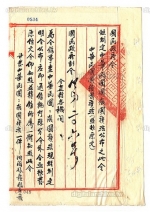
Written instruction from the National Government to all government authorities under the direct jurisdiction of the Central Government about the completion, promulgation, and implementation of the National Emblem and National Flag of the Republic of China Act
Written Instruction from the National Government to the KMT's Central Executive Council about the completion, promulgation, and implementation of the National Emblem and National Flag of the Republic of China Act
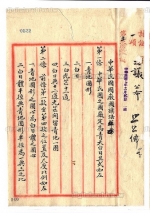
The National Emblem and National Flag of the Republic of China Act (November 2, 1928)
The National Emblem and National Flag of the Republic of China Act
The National Emblem and National Flag of the Republic of China Act
The Draft ROC National Emblem & National Flag Act with Illustrations (Drafted by: Wang Chong-Hui & Ku Ing-Feng)

Illustration on the Sizes, Ratios, and Techniques for Geometric Drawing of the National Emblem
The Draft ROC National Emblem & ROC National Flag Act with Illustrations
The Draft ROC National Emblem & ROC National Flag Act with Illustrations

Illustration on the Symbols, Sizes, Ratios, and Techniques for Geometric Drawing of the ROC National Flag
Written instruction from the KMT's Central Executive Council to the National Government regarding the confirmation, promulgation, and implementation of the “Terms of Fabrication and Use for the KMT Flag and ROC National Flag” passed at the 148th session of the assembly held by the KMT. (July 7, 1931)
Written instruction from the KMT's Central Executive Council to the National Government regarding the confirmation, promulgation, and implementation of the “Terms of Fabrication and Use for the KMT Flag and ROC National Flag” passed at the 148th session of the assembly held by the KMT. (July 7, 1931)
Terms of Fabrication and Use for the KMT Flag and ROC National Flag (July 2, 1931)
Terms of Fabrication and Use for the KMT Flag and ROC National Flag
Terms of Fabrication and Use for the KMT Flag and ROC National Flag
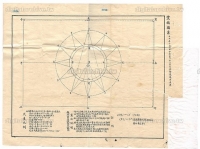
Graphic Pattern of the KMT Flag with Illustrations about its Sizes and Ratios, and the Techniques for Geometric Drawing of the Flag (October 8, 1928)

Graphic Pattern of the ROC National Flag with Illustrations about its Ratios and Sizes (October 8, 1928)
Illustration on the Scale of Various Sizes of the KMT Flag
Illustration on the Scale of Various Sizes of the ROC National Flag
|

























